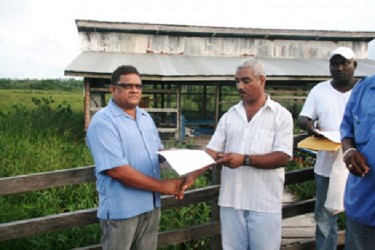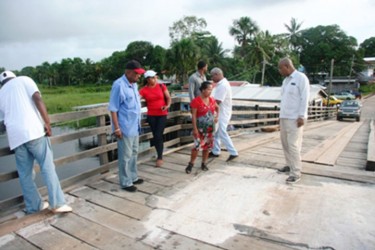A variation order valued $15.7M has been signed for repair work to start on the Kumaka-San Jose Bridge, North West with changes in the project specifications, the Government Information Agency said yesterday.
A GINA release said that Region One’s Regional Executive Officer Nigel Fisher signed the document with Deodat Singh in the presence of Minister in the Ministry of Local Government and Regional Development Norman Whittaker, and Minister in the Ministry of Finance Juan Edghill. The Ministers were both in the region over the weekend conducting separate outreaches to communities.

Singh was awarded a contract valued $28M in 2012 for the rehabilitation of the bridge which is vital for the Moruca sub-region. However, following concerns over defects in the earlier engineering design and the material utilised the work, was halted.
Work on the bridge will resume in two weeks, GINA said. This bridge is expected to be finished by August 22, as the new contract has a six–week duration.
GINA said that the existing narrow walkway of the bridge which lies between Kamwatta and Parakeese will be widened, allowing the movement of light vehicles.
In March of this year, residents of the area had expressed disquiet over the bridge works.
Then APNU MP Richard Allen had told Stabroek News that since Local Government Minister Ganga Persaud promised to have initial concerns addressed, including the re-use of decking boards, nothing had been done.
In February this year, after the residents voiced their displeasure about the construction of the bridge, the minister announced that an engineer from the city would be dispatched to the area to evaluate the works.
Allen said that the site was visited by himself, the Regional Executive Officer (REO), the contractor, the Assistant REO (AREO), as well as the Regional Engineer on December 6 last year, after residents had previously complained about the quality of works being done.

Allen said that some of the problems identified included the absence of a Clerk of Works at the site. It was also discovered that the Regional Engineer, whose responsibility it was to monitor the works, failed to make sufficient trips to evaluate the quality of works being done.
In addition, he said, the contractor who was charged with the construction of the bridge had pointed out several problems with the bridge’s design and had indicated these problems to the REO.
Several works had still not been completed at that point, though the bridge was to be completed last November, construction having commenced since last May. Allen added that concrete was still to be poured into tubing, which is to form part of the bridge’s support base.
Allen said at the time that the poles for the revetment had already sprawled, presumably since they were not of the required length.
He had also noted that an inspection of the bridge plans showed that no consideration was made for the construction of a left side railing. He said that the contractor nevertheless built the railing off his own initiative.

Furthermore, he said that the decking planks used on the bridge were insufficient, considering the heavy traffic that traverses the structure on a daily basis.
The general conception, according to Allen, was that the initial plans for the bridge had multiple flaws, which were identified and queried by the contractor, which should have been dealt with. He made it clear that though the contractor would have carried out the works, he would not be casting blame in his direction, since he would have pointed out the flaws from the inception.




